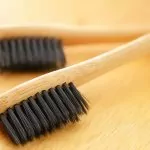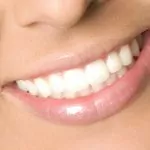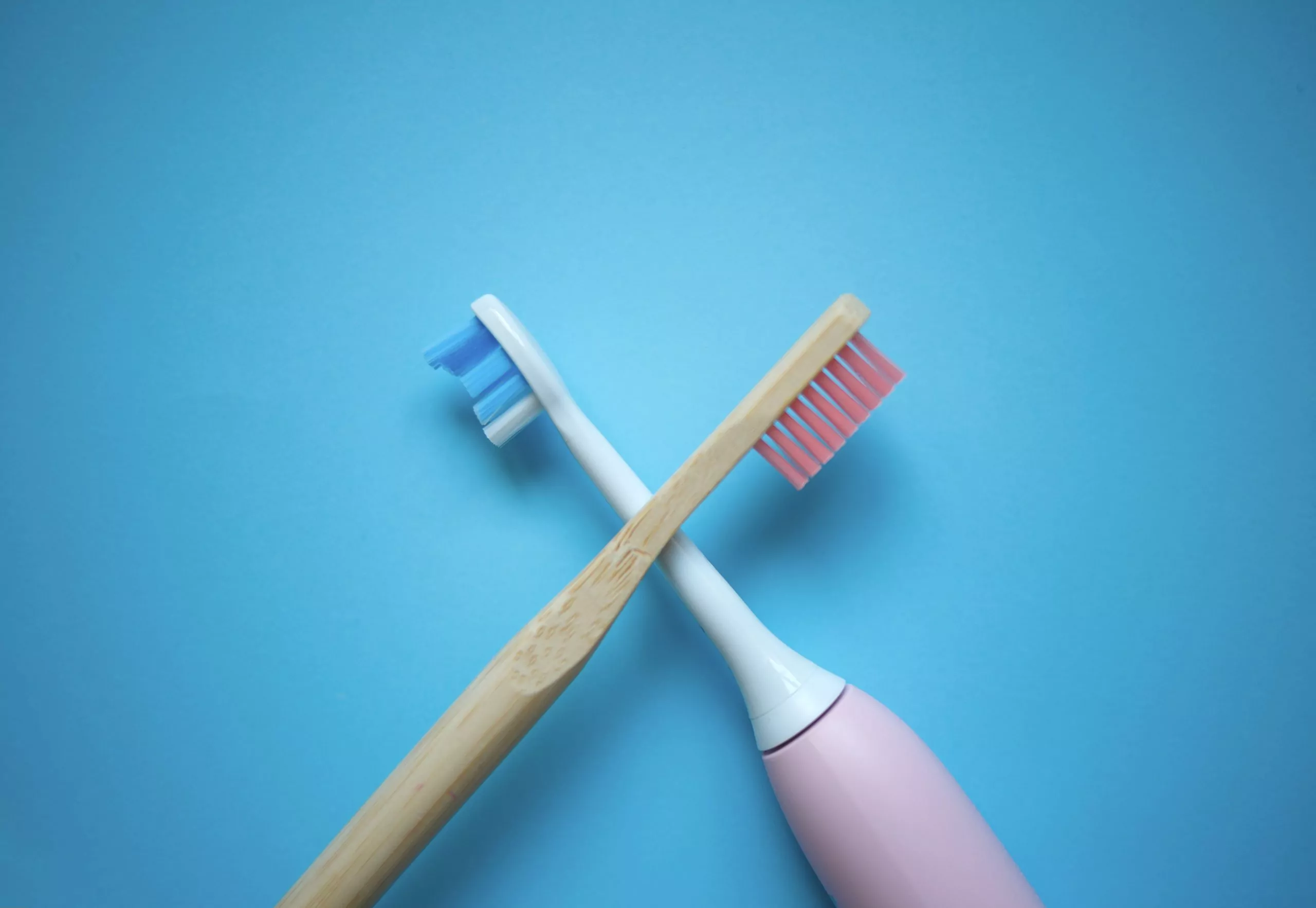Humans have been looking for innovative ways to ensure oral hygiene for centuries. From tree
bark to dental floss, the practices used have evolved, and with recent advances in technology, we
now have access to something that’s come a long way from the first progression – the water
flosser.
This blog post will look briefly at the evolution of dental floss, its types, and international
cleansers for optimum oral hygiene, and benefits of flossing.
History of Dental Floss

Dental floss is a cord of thin filament used to remove food debris and plaque from the interdental
areas where the toothbrush’s bristles cannot reach. From crude materials like horsehair and silk to
the synthetic fibers we use today, dental floss has evolved over the centuries.
It was in the early 1800s when a dentist named Levi Spear Parmly first introduced flossing as a
way to improve dental health. However, with the invention of nylon in the 1930s, dental floss
became widely used. Nylon quickly replaced silk because of its consistent texture and resistance
to shredding.
Types of Dental Floss
Several types of dental floss are available, making it difficult for many of us to pick the right one.
one. So, the indications for using a specific type of dental floss are given along with their
characteristics.

1.Waxed Dental Floss
Characteristics: Nylon or PTFE floss coated with wax for smooth gliding between teeth.
Indications: Effective in removing plaque, especially in areas with tight contact points.
- Unwaxed Dental Floss:
Characteristics: Usually made of nylon or Teflon without a wax coating.
Indications: Suitable for individuals who prefer a thinner floss or have more widely spaced teeth. - Coated Dental Floss:
Characteristics: Floss treated with substances like fluoride or antimicrobials for additional oral health benefits.
Indications: Offers extra protection against cavities and gum issues. - Flavored Dental Floss:
Characteristics: Infused with flavors like mint, cinnamon, or fruit for a more enjoyable flossing experience.
Indications: Encourages consistent flossing, particularly for those who find it less appealing. - Floss Picks:
Characteristics: Y-shaped plastic or disposable tools with a short piece of floss stretched between two prongs.
Indications: Convenient for people who prefer a one-handed flossing method or have difficulty using traditional floss. - Dental Tape or Tape Floss
Characteristics: Wider and flatter than regular floss, this type often comes in waxed and unwaxed varieties.
Indications: Ideal for individuals with more significant gaps between their teeth or braces, as it is less likely to shred or break. The greater surface area can also make it more effective at cleaning between the teeth. - Orthodontic Floss:
Characteristics: Thicker and sturdier floss designed for use with braces or dental appliances.
Indications: Ideal for individuals with orthodontic devices, ensuring effective cleaning around brackets and wires. - Super Floss
Characteristics: A unique, pre-cut strand of floss that combines a stiffened-end threader, spongy floss, and regular floss.
Indications: Particularly useful for individuals with braces, bridges, and wide gaps. The stiff end allows easy threading under and around appliances or spaces, while the spongy part cleans effectively around appliances and between wide spaces. Regular flossing helps remove plaque under the gumline. - Teflon Floss or PTFE Floss
Polytetrafluoroethylene (PTFE) floss is a type of dental floss that has gained popularity due to its unique properties.
Characteristics: PTFE floss is made from the same material used in high-tech applications like non-stick cookware. It’s highly durable, shred-resistant, and slides easily between closely spaced teeth.
Indications: PTFE floss is an excellent choice for those with tight teeth where traditional nylon floss can often fray or break. The smooth texture of PTFE floss minimizes discomfort while ensuring an effective clean. - Threader Floss
Characteristics: Incorporates a stiff threader at one end and a softer, regular floss at the other.
Indications: Primarily designed for people with braces or dental bridges to thread the floss under these appliances effectively. - Expanding Dental Floss
Characteristics: A type of dental floss that expands or thickens when it comes into contact with saliva or moisture.
Indications: Excellent for people with significant gaps between their teeth as it expands to fill the space, providing more surface area for effective cleaning. - Interdental Brushes
Characteristics: Small brushes designed to clean between the teeth where a regular toothbrush doesn’t reach.
Indications: Ideal for individuals with braces, bridges, or wide gaps between teeth. - Water Flosser
Characteristics: A handheld device sprays a thin stream of water, which is used to clean between the teeth and around the gumline.
Indications: Beneficial for those with braces and other types of dental work. It’s also a good option for people who find traditional flossing painful or difficult. - Electric Flosser
Characteristics: Battery-operated devices that use a nylon filament to remove food particles and plaque.
Indications: Suitable for individuals who prefer an automated approach to flossing. Useful for those with limited dexterity. - Floss Aids ( Flossing sticks and holder )
Characteristics: Small plastic tools that hold a piece of floss between two prongs or within a handle.
Indications: Helpful for those with limited dexterity or difficulty reaching certain areas of the mouth. It can also be helpful for children who are learning how to floss.
Techniques For Using Dental Floss
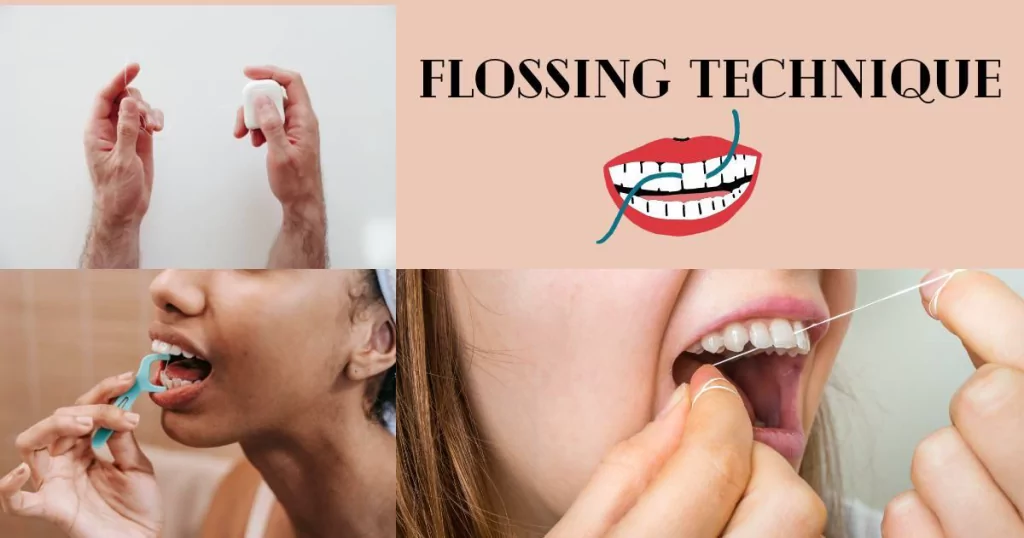
Start with Enough Floss:
- Begin with a piece of floss around 18 inches long. This ensures you have enough to use a fresh section between each pair of teeth.
Wrap Floss Around Fingers: - Wind the ends of the floss around your middle fingers, leaving a few inches of floss to work with.
Hold Floss Taut: - Hold the floss tightly between your thumbs and forefingers, leaving a one- to two-inch length for maneuvering.
Use a Gentle Sawing Motion: - Gently guide the floss between your teeth using a back-and-forth sawing motion to avoid snapping or damaging the gums.
Curve Around Each Tooth: - Form a C-shape with the floss around one tooth and gently slide it up and down against the side of the tooth and slightly below the gumline.
Move to a Fresh Section: - After cleaning one tooth, unwind a fresh section of floss from one hand while winding the used portion onto the other hand. This ensures you use a clean segment for each tooth.
Repeat for Each Tooth: - Continue this process for all teeth, including the back molars. Pay extra attention to any tight spaces or areas with dental work.
Be Gentle on Gums: - Avoid snapping or forcing the floss, as this can cause injury to the gums. Gently guide the floss between teeth.
Use Floss Holders or Picks: - If traditional floss is challenging, consider using floss holders or picks. These can be particularly helpful for reaching back teeth or those with dexterity issues.
Floss Daily: - Make flossing a daily habit to maintain optimal oral health. Consistency is key in preventing gum disease and cavities.
Remember to use a clean section of floss for each tooth, and make sure to get back behind the last tooth on each side, using a fresh selection of floss for this final step. Regularly using this technique will ensure that you keep your teeth clean and healthy and prevent dental problems in the long run.
Rise of Water Flosser: Recent Advancement

The rise of water flossers has completely revolutionized oral hygiene routines for people worldwide. Unlike traditional dental floss, water flossers use a water stream to remove food particles and plaque between teeth and below the gum line. Their price ranges from $50 to $200.
- To use a water flosser, fill the reservoir with water and attach the nozzle to the device.
- Adjust the pressure setting and turn it on, moving the nozzle along your gum line and between your teeth.
- The powerful stream of water cleanses your mouth thoroughly and efficiently in minutes.
- With this innovative technology, maintaining good oral hygiene has never been easier or more enjoyable!
Pros:
- Effective Plaque Removal:
- Gentle on Gums:
Gentle, pulsating water is less harsh on the gums, making it suitable for sensitive individuals.
- Customizable Pressure:
Adjustable water pressure settings allow for a personalized and comfortable experience.
- Orthodontic Care:
Particularly beneficial for individuals with braces, reaching areas traditional floss may miss.
- Convenient and accessible:
Easy to use, especially for those with dexterity issues; provides a convenient alternative to traditional floss.
Cons:
- Cost:
Initial investment can be higher compared to traditional floss.
- Maintenance:
Requires regular cleaning to prevent bacterial growth in the water reservoir.
- Portability:
Some models may be less convenient for travel compared to traditional floss.
- Learning Curve:
Users may take time to adapt to the technique of water flossing.
Advancements in Oral Hygiene

- Smart Features: Integration with timers, pressure sensors, and smart home technology.
- Innovative Nozzle Designs: Targeted nozzles for specific purposes, enhancing effectiveness.
- Compact Designs: Portable and travel-friendly options for on-the-go oral care.
- Reduced Bleeding: Contributing to improved gum health and reduced bleeding during oral care routines.
Practices for Proper Maintenance & Care of Your Water Flosser
Investing in a water flosser is a great way to maintain healthy teeth and gums, but it’s essential to properly keep and care for your unit to ensure it remains effective.
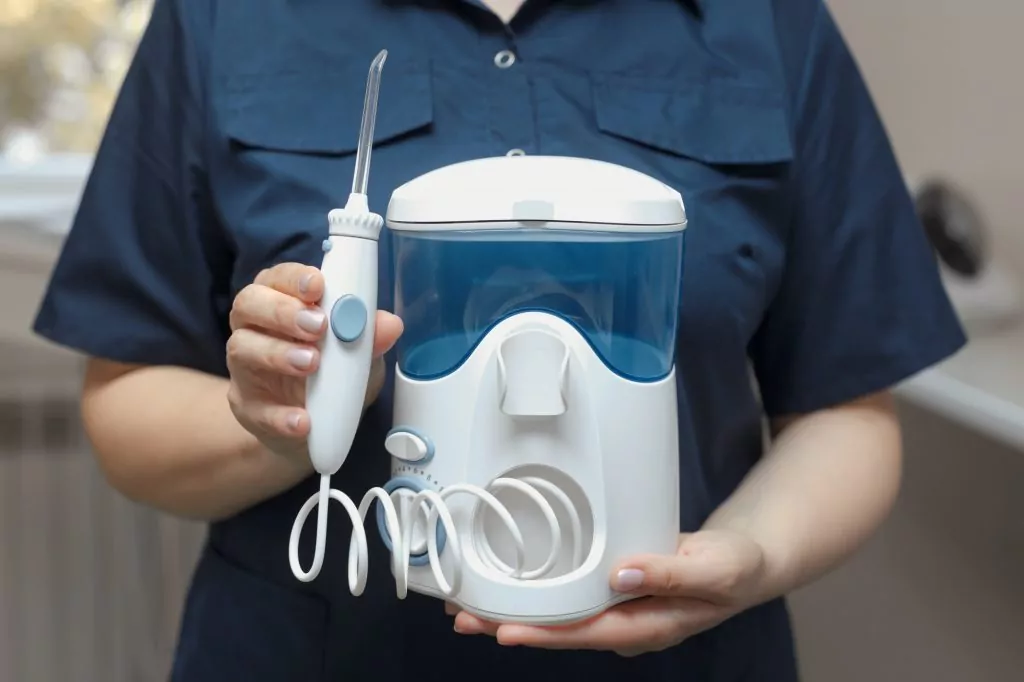
- One critical practice is regularly cleaning the flossing tip to prevent bacteria or buildup from affecting oral health.
- It’s also recommended to use a fluoride mouthwash to enhance the effectiveness of your water flosser.
- Remember to replace any disposable flossing tips as needed and thoroughly clean your unit at least once a month.
- Implementing these proper maintenance and care practices ensures your water flosser remains valuable in your oral hygiene routine.
- Read the guidelines written on the packaging.
What to Expect from Regular Use of a Water Flosser (Benefits of flossing)

- Regular water flossers can lead to healthier gums and fresher breath, as they help remove bacteria from your mouth without causing any harm to your teeth or gums.
- It’s a pain-free alternative to traditional floss that massages the gums and helps prevent gum disease.
- A water flosser is also ideal for people with braces, bridges, and other dental work, as it can clean around these areas without causing damage.
- Overall, using a water flosser regularly can lead to a healthier and cleaner smile.
Superfoods For Healthy Teeth and Gums
We all know that brushing and flossing are crucial for excellent oral health, but did you know that some foods can also help strengthen your teeth and gums?
These foods are called “superfoods,” including leafy green vegetables, almonds, salmon, yogurt, and green tea.

- Leafy Greens:
Spinach, Kale, and Swiss Chard: Rich in calcium for strong teeth and folic acid, which promotes gum health.
- Dairy Products:
Milk, Cheese, and Yogurt: Excellent sources of calcium and phosphorus, crucial for strengthening tooth enamel.
- Crunchy Fruits and Vegetables:
Apples, Carrots, and Celery: Their crunchy texture helps scrub away plaque and stimulate saliva production.
- Lean Proteins:
Chicken, Fish, and Eggs: Contain phosphorus, aiding in calcium absorption for healthy teeth.
- Nuts and Seeds:
Almonds, Walnuts, and Chia Seeds: Packed with vitamins and minerals, including calcium and magnesium.
- Tea (Green and Black):
Rich in Polyphenols: Compounds that can suppress bacteria, reducing plaque formation.
- Berries:
Strawberries, Blueberries, and Raspberries: High in antioxidants that help protect gums from inflammation.
- Water:
Hydration: Keeps the mouth moist, helps wash away food particles, and encourages saliva production.
- Onions:
Contain Sulfur Compounds: These compounds have antibacterial properties that can help fight bacteria in the mouth.
- Garlic:
Allicin Content: Natural antibacterial properties that can contribute to improved oral health.
Including various superfoods in your diet and proper oral hygiene practices can support overall dental health and contribute to strong teeth and healthy gums.
Why We Need Dental Floss Along with Toothbrush
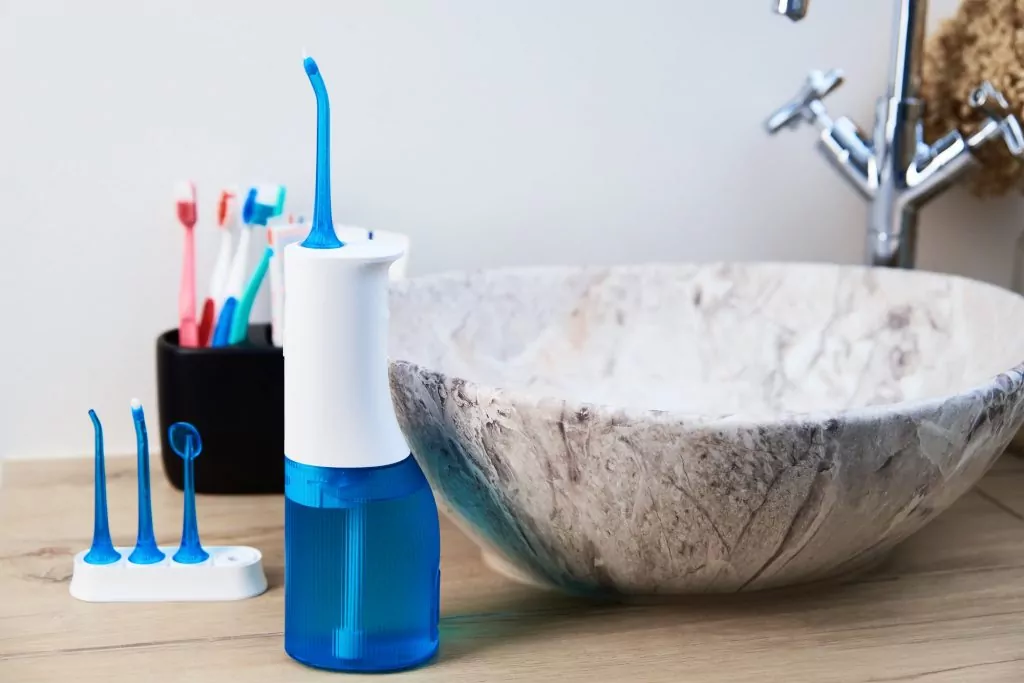
- We are all well aware of the importance of brushing our teeth, but did you know that flossing is equally crucial?
- Brushing alone cannot reach all the areas in your mouth where plaque builds up, nor can it remove the tiny food particles stuck between your teeth or below the gum line. This is where dental floss comes in handy.
- Flossing removes plaque from areas the toothbrush can’t reach, reducing the chances of cavities, gum disease, and bad breath. Therefore, flossing is essential to maintain optimal dental health in your daily dental care routine.
International Cleaners for Teeth
Sometimes, your toothbrush and dental floss can not do so much. Thankfully, there are other international cleaners for teeth to supplement your routine.
Miswak
One popular option is the Miswak (also known as chewing stick), a type of twig used in Middle Eastern, Asian, and African cultures to clean teeth and freshen breath for centuries. The twig contains natural antibacterial properties and even promotes gum health.
Oil pulling
Another popular choice is oil pulling, an ancient Ayurvedic practice from India where oil is swished around in the mouth to remove bacteria and residue.
Other international cleaners for teeth include the Japanese flossing technique called ‘shisa kanko,’ which involves making a shoelace-like knot out of floss, and the ancient Chinese practice of using tea to rinse the mouth.
With these options, maintaining a healthy smile is easier and more diverse than ever before!
Final Verdict
Thus, from the above information, we can conclude that dental floss is essential for keeping our teeth and gums healthy. Not only does it effectively remove plaque, but it also stimulates gum tissues.
Additionally, water flossers can help keep us in better shape if used regularly and dentist-approved methods are followed. Further, keeping up with your dental flossing routine, brushing twice daily, eating superfoods, and regular visits to the dentist will certainly keep your mouth healthy for years to come!
Now that you know about dental and water flossers, why not try them and keep your smile glowing? So what do you say? Are you up for the challenge?




